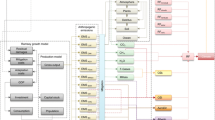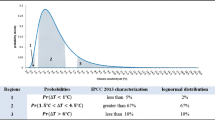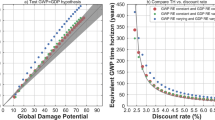Abstract
In this paper, we study optimal economic growth programs coupled with climate change dynamics. The study is based on models derived from MERGE, a well established integrated assessment model (IAM). We discuss first the introduction in MERGE of a set of “tolerable window” constraints which limit both the temperature change and the rate of temperature change. These constraints, obtained from ensemble simulations performed with the Bern 2.5-D climate model, allow us to identity a domain intended to preserve the Atlantic thermohaline circulation. Next, we report on experiments where a two-way coupling is realized between the economic module of MERGE and an intermediate complexity “3-D-” climate model (C-GOLDSTEIN) which computes the changes in climate and mean temperature. The coupling is achieved through the implementation of an advanced “oracle based optimization technique” which permits the integration of information coming from the climate model during the search for the optimal economic growth path. Both cost-effectiveness and cost-benefit analysis modes are explored with this combined “meta-model” which we refer to as GOLDMERGE. Some perspectives on future implementations of these approaches in the context of “collaborative” or “community” integrated assessment modules are derived from the comparison of the different approaches.
Similar content being viewed by others
References
Aubin J-P, Bernardo T, Saint-Pierre P (2005) A viability approach to global climate change issues. In: Haurie A and Viguier L (eds.) The coupling of climate and economic dynamics. Kluwer, pp 113–140
Babonneau F, Beltran C, Haurie A, Tadonki C, Vial J-P (2005) Proximal-ACCPM: a versatile oracle based optimization method. Computational and Management Science. Submitted.
Bahn O, Edwards N, Knutti R, Stocker T (2004) Climate policy preserving an atlantic thermohaline circulation collapse. Climatic Change. Submitted. Available in Les Cahiers du GERAD, reference G-2004-72
Bruckner T, Zickfeld K (2004) Low risk emissions corridors for safeguarding the atlantic thermohaline circulation. In: paper presented at the Expert Workshop “Greenhouse Gas Emissions and Abrupt Climate Change”, Paris.
Drouet L, Beltran C, Edwards N, Haurie A, Vial J-P, Zachary D (2005a) An oracle method to couple climate and economic dynamics. In: Haurie A and Viguier L (eds.) The coupling of climate and economic dynamics. Kluwer, pp 69–94
Drouet L, Edwards N, Haurie (2005b) Coupling climate and economic models in a cost-benefit framework: a convex optimization approach. Environmental Modeling and Assessment. Submitted.
Edwards N, Marsh R (2005) Uncertainties due to transport-parameter sensitivity in an efficient 3-D ocean-climate model. Climate Dynamics 24:415–433
Goffin J-L, Haurie A, Vial J-P (1992) Decomposition and non-differentiable optimization with the projective algorithm. Management Science 38:284–302
Gordon C, Cooper C, Senior C, Banks H, Gregory J, Johns T, Mitchell J, Wood R (2000) The simulation of SST, sea-ice extents and ocean heat transports in a version of the Hadley Centre coupled model without flux adjustments. Climate Dynamics 16:147–168
Haarsma R, Goosse H, Selten F, JD Opsteegh (2001) Decadal variability in high northern latitudes as simulated by an intermediate-complexity climate model. Annals of Glaciology 33:525–532
Hargreaves J, Annan J, Edwards N, Marsh R (2005) Climate forecasting using an intermediate complexity earth system model and the ensemble kalman filter. Climate Dynamics 23(7–8):745–760
IPCC (2001a) Climate change 2001: mitigation, contribution of working group III to the third assessment report of the intergovernmental panel on climate change. Metz B et al. (eds) Cambridge University Press. Cambridge, U.K.
IPCC (2001b) Climate change 2001: the scientific basis, contribution ofworking group I to the third assessment report of the intergovernmental panel on climate change. Houghton J et al. (eds) Cambridge University Press, Cambridge, U.K.
Jaeger CC, Leimbach M, Carraro C, Hasselmann K, Hourcade JC, Keeler A, Klein R (2002) Integrated assessment modeling: modules for cooperation. FEEM Working Paper No. 53
Keller K, Bolker B, Bradford D (2004) Uncertain climate thresholds and optimal economic growth. Journal of Environmental Economics and Management 48(1):723–741
Knutti R, Meehl G, Allen MR, Stainforth DA (2005) Constraining climate sensitivity from the seasonal cycle in surface temperature. J. Clim. 19:4224–4233
Knutti R, Stocker T (2002) Limited predictability of the future thermohaline circulation close to an instability threshold. Journal of Climate 15:179–186
Knutti R, Stocker T, Joos F, Plattner G-K (2002) Constraints on radiative forcing and future climate change from observations and climate model ensembles. Nature 416:719–723
Knutti R, Stocker TF, Joos F, Plattner G-K (2003) Probabilistic climate change projections using neural networks. Climate Dynamics 21:257–272
Leimbach M, Jaeger C (2004) A modular approach to integrated assessment modeling. Environmental Modelling and Assessment 9(4):207–220
Lenton TM, Williamson MS, Edwards NR, Marsh R, Price AR, Ridgwell AJ, Shepherd JG, and the GENIE team (2005) Millennial timescale carbon cycle and climate change in an efficient Earth system model. Climate Dynamics. Submitted.
Manne A, Mendelsohn R, Richels R (1995) MERGE - a model for evaluating regional and global effects of GHG reduction policies. Energy Policy 23(1):17–34
Manne A, Richels R (2005) MERGE: an integrated assessment model for global climate change. In: Loulou R, Waaub J-P, Zaccour G, (eds) Energy and Environment. GERAD 25th Anniversary Series. Springer, pp 175–189
Moré J (1983) Recent developments in algorithms and software for trust region methods. In: Mathematical Programming: The State of the Art. Springer Verlag, Berlin, pp. 258–287
Negishi T (1972) General equilibrium theory and international trade. North-Holland.
Nordhaus W (1993) Rolling the ‘DICE’: an optimal transition path for controlling greenhouse gases. Resource and Energy Economics 15:27–50
Nordhaus W, Boyer J (2000) Warming the world: economic models of global warming. MIT Press
Péton O, Vial J-P (2001) A brief tutorial on ACCPM. Technical report. Logilab, University of Geneva
Prinn R, et al. (1999) Integrated global system model for climate policy assessment: feedbacks and sensitivity studies. Climatic Change 3/4(41):469–546
Schmittner A, Stocker T (1999) The stability of the thermohaline circulation in global warming experiments. Journal of Climate 12:1117–1133
Schramm H, Zowe J (1992) A version of the bundle idea for minimizing a non-smooth function: conceptual idea, convergence analysis, numerical results. SIAM Journal on Optimization 2:121–152
Stainforth D, et al (2005) Uncertainty in predictions of the climate response to rising levels of greenhouse gases. Nature 433:403–406
Stocker T, Schmittner A (1997) Influence of CO2 emissions rates on the stability of the thermohaline circulation. Nature 388:862–865
Stocker T, Wright D, Mysak L (1992) A zonally averaged, coupled ocean-atmosphere model for paleoclimate studies. Journal of Climate 4:773–797
Stott P, Mitchell J, Gregory J, Santer B, Meehl G, Delworth T, Allen M (2005) Observational constraints on past attributable warming and predictions of future global warming. J. Climate 19:3055–3069
Toth F, Bruckner T, Fuessel H-M, Leimbach M, Petshel-Held G (2003) Integrated assessment of long-term climate policies: part 1 —model presentation. Climatic Change 56:37–56
WBGU (2003) Climate protection strategies for the 21st century. Earthscan, London.
Weaver A, Eby M, Wiebe E, Bitz C, Duffy P, Ewen T, Fanning A, Holland M, MacFadyen A, Matthews H, Meissner K, Saenko O, Schmittner A, Wang H, Yoshimori M (2001) The UVic earth system climate model: model description, climatology, and applications to past, present and future climates. Atmos-Ocean 39:361–428
Author information
Authors and Affiliations
Corresponding author
Rights and permissions
About this article
Cite this article
Bahn, O., Drouet, L., Edwards, N.R. et al. The coupling of optimal economic growth and climate dynamics. Climatic Change 79, 103–119 (2006). https://doi.org/10.1007/s10584-006-9108-4
Received:
Revised:
Accepted:
Published:
Issue Date:
DOI: https://doi.org/10.1007/s10584-006-9108-4




